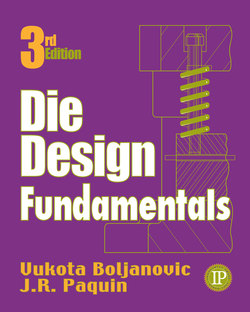Читать книгу Die Design Fundamentals - Vukota Boljanovic - Страница 5
На сайте Литреса книга снята с продажи.
ОглавлениеPREFACE TO THIRD EDITION
The field of tool engineering and die design, a complex and fascinating subject, continues to advance rapidly. This broad and challenging topic continues to incorporate new concepts at an increasing rate, making tool and die design a dynamic and exciting field of study. In preparing this third edition, my most important goal has been to provide a comprehensive state-of-the-art textbook on die design fundamentals, which also encompasses the additional aims of motivating and challenging students.
This new edition provides balanced coverage of relevant fundamentals and real-world practices so that the student can understand the important and often complex interrelationships between die design and the economic factors involved in manufacturing sheet metal-forming products.
A groundbreaking and comprehensive reference with many thousands of copies sold since it first debuted in 1962 as J.R. Paquin’s Die Design Fundamentals, this new third edition of Die Design Fundamentals basically follows the same design philosophy: It is a step-by-step introduction to the design of stamping dies. However, the original book has been completely revised and updated, and the order of the chapters has been changed to follow the logical process of designing a die.
The plan of the book remains unique. After introductory material and a discussion of 20 types of dies, the design of a representative die is separated into 14 distinct steps. Each step is illustrated in two ways: first, as a portion of an engineering drawing, that is, as the component is actually drawn on the design; second, the die design is shown pictorially in order to improve the user’s visualization. In successive sections of the book, each step is detailed as it is applied to the design of the various types of dies listed in Chapter 2. In many figures a punch shank is shown because it is still in everyday use in many small stamping shops. However, according to the OSHA Standard 1910.217(7) it cannot be used for clamping the punch holder to the slide (ram) of a press, but can be used for aligning the die in the press. Slide (ram) mounting holes or another clamping system must be provided in the punch holder for fastening. The final chapter deals with presses and quick die-changing (QDC) systems.
The intent of this new edition is to provide students, instructors, and working professionals with graphically detailed assistance in understanding the underlying principles of designing single-station dies as well as small progressive dies of a type generally used once for short runs of parts manually cut from strip sheared from sheets.
For the first time, a dual (English and metric) system is included. New methods of producing blanks widely acknowledged within the industry, such as waterjet cutting and laser cutting are included, as well. The chapter 20 “Presses and Quick Die-Change Systems” has been considerably revised, with the addition of a new subtopic, “Quick Die-Change Systems.” To this third edition of the book has also been added a Glossary of the terms used.
In response to comments and suggestions by numerous reviewers, several major and minor changes have also been made throughout the text. A page-by-page comparison with the second edition will show that literally hundred of changes have been made for improved clarity and completeness.
It is hoped that by reading and studying this third edition of the book, students and other users will come to appreciate the vital nature of tool and die engineering as an academic subject that is as exciting, challenging, and as important as any other engineering and technology discipline.
The author of the third edition owes much to many people. I am grateful to my son Sasha for valuable contributions in the preparation of this edition. Finally, I wish to thank Em Turner Chitty for her competent proofreading of this new edition.
Vukota Boljanovic
Knoxville, Tennessee
